 W
WThe human genome is a complete set of nucleic acid sequences for humans, encoded as DNA within the 23 chromosome pairs in cell nuclei and in a small DNA molecule found within individual mitochondria. These are usually treated separately as the nuclear genome, and the mitochondrial genome. Human genomes include both protein-coding DNA genes and noncoding DNA. Haploid human genomes, which are contained in germ cells consist of three billion DNA base pairs, while diploid genomes have twice the DNA content. While there are significant differences among the genomes of human individuals, these are considerably smaller than the differences between humans and their closest living relatives, the bonobos and chimpanzees.
 W
WC12Orf24 is a gene in humans that encodes a protein known as FAM216A. This gene is primarily expressed in the testis and brain, but has constitutive expression in 25 other tissues. FAM216A is an intracellular protein that has been predicted to reside within the nucleus of cells. The exact function of C12Orf24 is unknown. FAM216A is highly expressed in Sertoli cells of the testis as well as different stage spermatids.
 W
WChromosome 1 is the designation for the largest human chromosome. Humans have two copies of chromosome 1, as they do with all of the autosomes, which are the non-sex chromosomes. Chromosome 1 spans about 249 million nucleotide base pairs, which are the basic units of information for DNA. It represents about 8% of the total DNA in human cells.
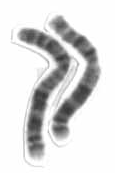 W
WChromosome 2 is one of the twenty-three pairs of chromosomes in humans. People normally have two copies of this chromosome. Chromosome 2 is the second-largest human chromosome, spanning more than 242 million base pairs and representing almost eight percent of the total DNA in human cells.
 W
WChromosome 3 is one of the 23 pairs of chromosomes in humans. People normally have two copies of this chromosome. Chromosome 3 spans almost 200 million base pairs and represents about 6.5 percent of the total DNA in cells.
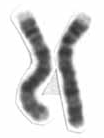 W
WChromosome 4 is one of the 23 pairs of chromosomes in humans. People normally have two copies of this chromosome. Chromosome 4 spans more than 186 million base pairs and represents between 6 and 6.5 percent of the total DNA in cells.
 W
WChromosome 5 is one of the 23 pairs of chromosomes in humans. People normally have two copies of this chromosome. Chromosome 5 spans about 181 million base pairs and represents almost 6% of the total DNA in cells. Chromosome 5 is the 5th largest human chromosome, yet has one of the lowest gene densities. This is partially explained by numerous gene-poor regions that display a remarkable degree of non-coding and syntenic conservation with non-mammalian vertebrates, suggesting they are functionally constrained.
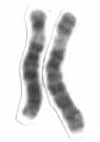 W
WChromosome 6 is one of the 23 pairs of chromosomes in humans. People normally have two copies of this chromosome. Chromosome 6 spans more than 170 million base pairs and represents between 5.5 and 6% of the total DNA in cells. It contains the Major Histocompatibility Complex, which contains over 100 genes related to the immune response, and plays a vital role in organ transplantation.
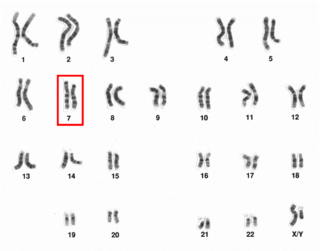 W
WChromosome 7 is one of the 23 pairs of chromosomes in humans, who normally have two copies of this chromosome. Chromosome 7 spans about 159 million base pairs and represents between 5 and 5.5 percent of the total DNA in cells.
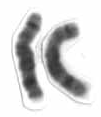 W
WChromosome 8 is one of the 23 pairs of chromosomes in humans. People normally have two copies of this chromosome. Chromosome 8 spans about 145 million base pairs and represents between 4.5 and 5.0% of the total DNA in cells.
 W
WChromosome 9 is one of the 23 pairs of chromosomes in humans. Humans normally have two copies of this chromosome, as they normally do with all chromosomes. Chromosome 9 spans about 138 million base pairs of nucleic acids and represents between 4.0 and 4.5% of the total DNA in cells.
 W
WChromosome 10 is one of the 23 pairs of chromosomes in humans. People normally have two copies of this chromosome. Chromosome 10 spans about 133 million base pairs and represents between 4 and 4.5 percent of the total DNA in cells.
 W
WChromosome 11 is one of the 23 pairs of chromosomes in humans. Humans normally have two copies of this chromosome. Chromosome 11 spans about 135 million base pairs and represents between 4 and 4.5 percent of the total DNA in cells. The shorter arm is termed 11p while the longer arm is 11q. At about 21.5 genes per megabase, chromosome 11 is one of the most gene-rich, and disease-rich, chromosomes in the human genome.
 W
WChromosome 12 is one of the 23 pairs of chromosomes in humans. People normally have two copies of this chromosome. Chromosome 12 spans about 133 million base pairs and represents between 4 and 4.5 percent of the total DNA in cells.
 W
WChromosome 13 is one of the 23 pairs of chromosomes in humans. People normally have two copies of this chromosome. Chromosome 13 spans about 114 million base pairs and represents between 3.5 and 4% of the total DNA in cells.
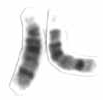 W
WChromosome 14 is one of the 23 pairs of chromosomes in humans. People normally have two copies of this chromosome. Chromosome 14 spans about 107 million base pairs and represents between 3 and 3.5% of the total DNA in cells.
 W
WChromosome 15 is one of the 23 pairs of chromosomes in humans. People normally have two copies of this chromosome. Chromosome 15 spans about 101 million base pairs and represents between 3% and 3.5% of the total DNA in cells.
 W
WChromosome 16 is one of the 23 pairs of chromosomes in humans. People normally have two copies of this chromosome. Chromosome 16 spans about 90 million base pairs and represents just under 3% of the total DNA in cells.
 W
WChromosome 17 is one of the 23 pairs of chromosomes in humans. People normally have two copies of this chromosome. Chromosome 17 spans more than 83 million base pairs and represents between 2.5 and 3% of the total DNA in cells.
 W
WChromosome 18 is one of the 23 pairs of chromosomes in humans. People normally have two copies of this chromosome. Chromosome 18 spans about 80 million base pairs and represents about 2.5 percent of the total DNA in cells.
 W
WChromosome 19 is one of the 23 pairs of chromosomes in humans. People normally have two copies of this chromosome. Chromosome 19 spans more than 58.6 million base pairs, the building material of DNA.
 W
WChromosome 20 is one of the 23 pairs of chromosomes in humans. Chromosome 20 spans around 63 million base pairs and represents between 2 and 2.5 percent of the total DNA in cells. Chromosome 20 was fully sequenced in 2001 and was reported to contain over 59 million base pairs. Since then, due to sequencing improvements and fixes, the length of chromosome 20 has been updated to just over 63 million base pairs.
 W
WChromosome 21 is one of the 23 pairs of chromosomes in humans. Chromosome 21 is both the smallest human autosome and chromosome, with 48 million base pairs representing about 1.5 percent of the total DNA in cells. Most people have two copies of chromosome 21, while those with three copies of chromosome 21 have Down syndrome, also called "trisomy 21".
 W
WChromosome 22 is one of the 23 pairs of chromosomes in human cells. Humans normally have two copies of chromosome 22 in each cell. Chromosome 22 is the second smallest human chromosome, spanning about 49 million DNA base pairs and representing between 1.5 and 2% of the total DNA in cells.
 W
WThe X chromosome is one of the two sex-determining chromosomes (allosomes) in many organisms, including mammals, and is found in both males and females. It is a part of the XY sex-determination system and X0 sex-determination system. The X chromosome was named for its unique properties by early researchers, which resulted in the naming of its counterpart Y chromosome, for the next letter in the alphabet, following its subsequent discovery.
 W
WThe Y chromosome is one of two sex chromosomes (allosomes) in therian mammals, including humans, and many other animals. The other is the X chromosome. Y is normally the sex-determining chromosome in many species, since it is the presence or absence of Y that typically determines the male or female sex of offspring produced in sexual reproduction. In mammals, the Y chromosome contains the gene SRY, which triggers male development. The DNA in the human Y chromosome is composed of about 59 million base pairs. The Y chromosome is passed only from father to son. With a 30% difference between humans and chimpanzees, the Y chromosome is one of the fastest-evolving parts of the human genome. The human Y chromosome carries an estimated 100-200 genes, with between 45 and 73 of these protein-coding. All single-copy Y-linked genes are hemizygous except in cases of aneuploidy such as XYY syndrome or XXYY syndrome.
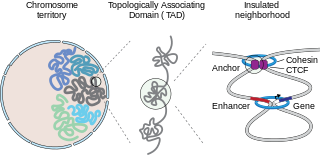 W
WIn mammalian biology, insulated neighborhoods are chromosomal loop structures formed by the physical interaction of two DNA loci bound by the transcription factor CTCF and co-occupied by cohesin. Insulated neighborhoods are thought to be structural and functional units of gene control because their integrity is important for normal gene regulation. Current evidence suggests that these structures form the mechanistic underpinnings of higher-order chromosome structures, including topologically associating domains (TADs). Insulated neighborhoods are functionally important in understanding gene regulation in normal cells and dysregulated gene expression in disease.